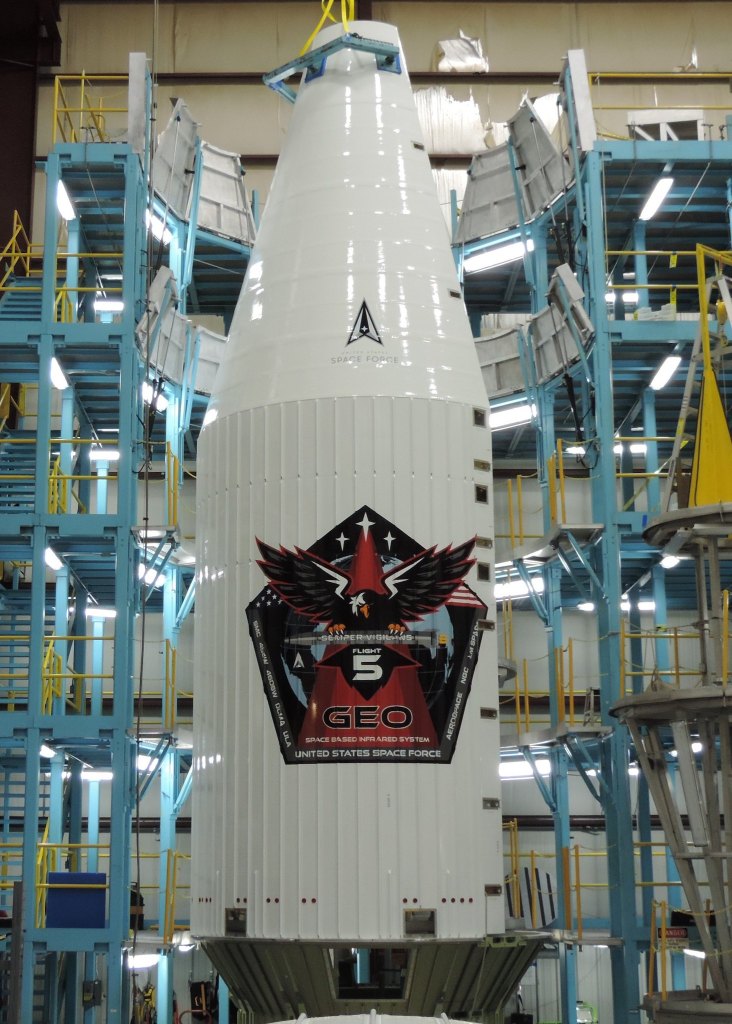Featured image credit: ULA
Launch Window | August 4, 2022 – 10:29 – 11:09 UTC | 06:29 – 07:09 EDT |
|---|---|
Mission Name | SBIRS GEO-6 |
Launch Provider | United Launch Alliance (ULA) |
Customer | United States Space Force |
Rocket | Atlas V 421 |
Launch Location | Space Launch Complex-41, Cape Canaveral Space Force Station, Florida, USA |
Payload mass | 4,500 kg (~10,000) |
Where are the satellite(s) going? | Geostationary Transfer Orbit (GTO) |
Will they be attempting to recover the first stage? | No, this is not a capability of ULA |
Where will the first stage land? | It will crash into the Atlantic Ocean |
Will they be attempting to recover the fairings? | No, this is not a capability of ULA |
Are these fairings new? | Yes |
How’s the weather looking? | The weather is currently 70% GO for launch (as of August 01, 2022 – 12:30 UTC) |
This will be the: | – 5th launch of ULA in 2022 – 79th Atlas V launch from Cape Canaveral – 9th launch of an Atlas V in the 421 configuration – 152nd ULA mission – 93rd orbital launch of 2022 |
Where to watch | If available, an official livestream will be listed here |
What Does All This Mean?
ULA will launch the SBIRS GEO-6 satellite atop an Atlas V rocket in the 421 configuration for the United States Space Force’s Space Systems Command (SSC). The rocket is scheduled to lift off from Space Launch Complex-41 at Cape Canaveral Space Force Station, Florida, USA on August 4, 2022.
What Is The SBIRS GEO-6 Mission?
The Space Based Infrared System (SBIRS) is a network of satellites and hosted payloads in Geosynchronous Earth Orbit (GEO) and Highly Elliptical Orbit (HEO), which utilize scanning and staring infrared sensors to provide early missile warning and defense capabilities to the U.S Space Force’s Space and Missile Systems Center. The main aim of the program is to support missile defense, missile warning, battlespace awareness, and technical intelligence.
SBIRS GEO-6 is the sixth and final satellite in the program, which was designed to replace the Defense Support Program, Northrop Grumman’s system of early warning satellites, which has been in operation since the 1970s. The first of the SBIRS satellites was launched in 2011, with subsequent satellites being launched in 2013, 2017, and 2018.
While this is the 6th SBIRS spacecraft to be built by Lockheed Martin, it is the second to be built on the company’s LM 2100 combat bus, which provides enhanced security features, and improved power, propulsion, and electronics. The SBIRS GEO-5 satellite was the first to be built on the LM 2100M bus.
An Atlas V rocket will be used to take the satellite to Geostationary Transfer Orbit (GTO), after which the satellite will use its own propulsion system to gradually raise its orbit to geosynchronous orbit.

SBIRS GEO-5 Flight Profile
| Hrs:Min:Sec From Lift-Off | Events |
| 0:00:00 | Liftoff |
| 0:00:47 | Maximum Dynamic Pressure (Max Q) |
| 0:02:09 | SRB Jettison |
| 0:04:10 | Atlas Booster Engine Cutoff |
| 0:04:16 | Atlas Centaur Separation |
| 0:04:26 | Centaur Main Engine Start (MES-1) |
| 0:04:34 | Payload Fairing Jettison |
| 0:15:06 | Centaur Main Engine Cutoff (MECO-1) |
| 0:15:37 | EZ-3 Deployment |
| 0:16:25 | EZ-4 Deployment |
| 0:31:06 | Centaur Main Engine Start (MES-2) |
| 0:34:27 | Centaur Main Engine Cutoff (MECO-2) |
| 0:42:26 | SBIRS GEO-5 Separation |

What Is The Atlas V?
The Atlas V is an expendable medium lift launch system and member of the Atlas rocket family. The rocket is one of the most reliable in the world, having more than 76 launches (As of November 2020) with no complete failures.
The rocket has two stages. The first is a Common Core Booster (CCB), which is powered by an RD-180 engine and burns kerosene (RP-1) and liquid oxygen (LOx). This is accompanied by up to five strap-on solid rocket boosters. The second stage is the Centaur upper stage, which is powered by one or two RL10 engines and burns liquid hydrogen (LH2) and liquid oxygen (LOx).
In the 421 configuration, the Atlas V is capable of carrying up to 14,067 kg to Low Earth Orbit (LEO), and 6,890 kg to Geostationary Transfer Orbit (GTO).
What Does 421 Mean?
Atlas V rockets have a three number configuration code. The first number represents the fairing diameter size in meters, so in this instance there is a 4 meter fairing. The second number denotes the number of solid rocket boosters (SRBs), which attach to the base of the rocket. The number of SRBs for a 4 meter fairing can range from 0 – 3. In this case there will be 2 SRBs attached to the center core. The third number shows the number of engines on the Centaur Upper Stage, which is 1 in this configuration. So this means that this rocket will have a 4 meter faring, 2 solid rocket boosters, and 1 engine on the Centaur Upper Stage.






